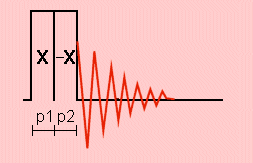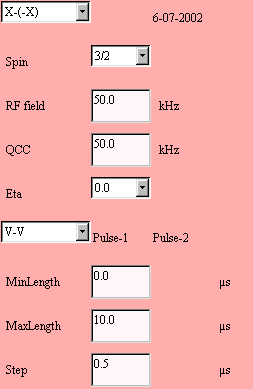AIM: Determination of the quadrupole coupling constant from a featureless NMR lineshape
Launch the rotary-echo pulse applet with Java Web Start.

Despite the name of this sequence, we do not perform echo experiments because the signal is observed at the end of the second pulse.
Two rotary-echo sequences are presented:
X-(-X): {+X,-X}-acq(y)
Even-X: {+X,-X}-acq(y)
Even-X: {-X,-X}-acq(y)
These two sequences do not cancel spurious signals whereas the composite-pulse sequence does. On the other hand, if the two pulse-lengths are identical (p1 = p2), the X-(-X) sequence cancels signals with small and large quadrupolar coupling constants.

The left part of the panel indicates the parameters of the simulation. It is preset for a typical experiment on a spin I = 3/2 in a powder. You can introduce your own values.
First, we select the rotary-echo sequence with the upper choice box.
Then, we select the line intensity calculation with the lower
choice box:
(1) V-V: p1 and p2 vary identically;
(2) V-F: p1 varies and p2 remains constant;
(3) F-V: p1 remains constant and p2 varies.
When p1 = p2, only the parameters for p1 are required.
A constant pulse length should be provided in the MinLength field.
MinLength: the first variable pulse-length in µs
MaxLength: the last variable pulse-length in µs
Step: the increment of the variable pulse-length in µs
The following applet is initialized for the central-line intensity of a spin I = 3/2 in a powder excited by the X-(-X) rotary-echo sequence where the two pulse-lengths vary identically. The experimental line intensities are identical to the simulated ones.
Help for selecting all the simulated data of the line intensity text area in a JDK1.1.8 applet.
